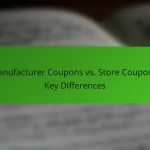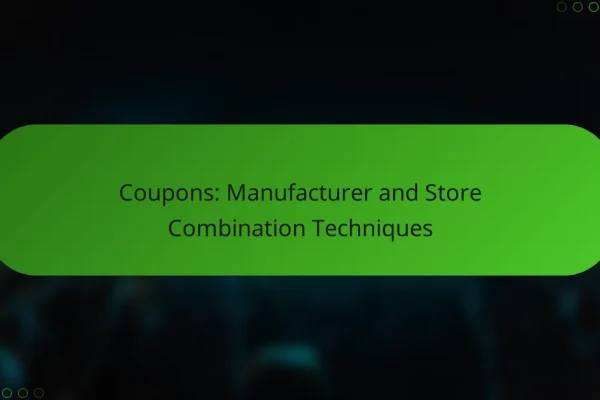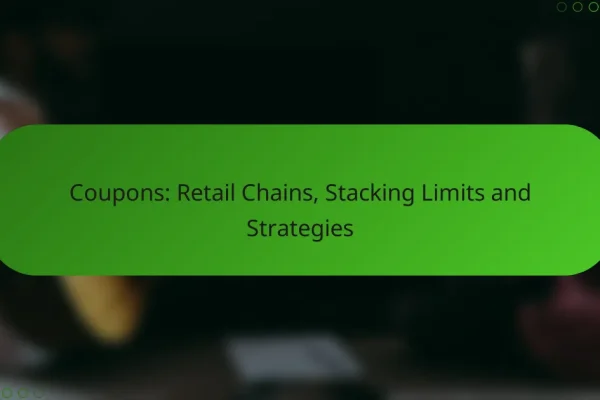How can you effectively stack coupons in the USA?
Effectively stacking coupons in the USA involves combining different types of discounts to maximize savings on purchases. This can include using manufacturer coupons alongside store coupons, leveraging cashback apps, and applying loyalty program discounts.
Combining manufacturer and store coupons
Combining manufacturer and store coupons is a common strategy for maximizing savings. Manufacturer coupons are issued by the brand and can often be used at any store, while store coupons are specific to a retailer and can usually be stacked with manufacturer offers. For example, if a cereal is on sale for $3 and you have a $1 manufacturer coupon and a $0.50 store coupon, you can pay just $1.50.
However, not all stores allow stacking, so it’s essential to check the store’s coupon policy before shopping. Some retailers may have specific rules regarding how many coupons can be used on a single item, so familiarize yourself with these guidelines to avoid disappointment at checkout.
Using cashback apps alongside coupons
Cashback apps can be used in conjunction with coupons to enhance your savings further. These apps allow you to earn a percentage of your purchase back after submitting a receipt, effectively adding to the discount you receive from coupons. For instance, if you buy groceries worth $50 and use $10 in coupons, you can still receive cashback on the total amount spent.
To maximize benefits, choose cashback apps that offer rebates on items you frequently purchase. Always check the app for available offers before shopping, as some apps may require you to select offers in advance to qualify for cashback.
Applying loyalty program discounts
Loyalty programs often provide additional discounts and rewards that can be stacked with coupons. By signing up for a store’s loyalty program, you can earn points for every purchase, which can later be redeemed for discounts or free items. Some programs also offer exclusive coupons or promotions to members.
To make the most of loyalty programs, regularly check your account for available rewards and special offers. Be mindful of expiration dates on points and coupons to ensure you don’t miss out on savings. Additionally, consider using loyalty cards in conjunction with other coupons to maximize your overall discount on purchases.
What are the best coupon stacking strategies?
The best coupon stacking strategies involve combining different types of discounts to maximize savings. This can include using both digital and paper coupons, timing purchases with sales events, and utilizing online promo codes effectively.
Stacking digital and paper coupons
Stacking digital and paper coupons allows shoppers to leverage multiple discounts on a single purchase. Many retailers permit the use of a digital coupon alongside a paper coupon, provided they are from different sources. Always check the store’s policy to ensure compliance.
For example, if a grocery store offers a digital coupon for 20% off and you have a paper coupon for $5 off, you can typically use both to maximize your savings. Keep an eye on expiration dates and terms to avoid missing out on potential discounts.
Timing purchases with sales events
Timing your purchases during sales events can significantly enhance coupon stacking effectiveness. Retailers often have seasonal sales, clearance events, or holiday promotions where additional discounts apply. Aligning your coupon usage with these events can lead to substantial savings.
For instance, if a store has a buy-one-get-one-free (BOGO) sale, using a coupon on the item can yield a double discount. Plan ahead by checking store flyers or websites for upcoming sales to optimize your shopping strategy.
Utilizing online promo codes
Online promo codes are a powerful tool for coupon stacking, especially for e-commerce purchases. Many retailers offer promo codes that can be applied at checkout, often in conjunction with other discounts or sales. Always search for available codes before completing a purchase.
For example, if you find a promo code for 15% off and the item is already on sale, applying both can lead to significant savings. Websites that aggregate promo codes can be useful, but ensure they are reputable to avoid expired or invalid codes.
Which retailers allow coupon stacking?
Many retailers permit coupon stacking, allowing customers to combine multiple discounts for greater savings. However, policies vary widely, so it’s essential to check each retailer’s specific rules before shopping.
Target coupon stacking policies
Target generally allows coupon stacking, but with specific limitations. Shoppers can combine one manufacturer coupon with one Target coupon on a single item. Additionally, Target often runs promotions that can be stacked with coupons, enhancing overall savings.
For example, if you have a manufacturer coupon for $1 off a product and a Target coupon for $0.50 off, you can use both, saving a total of $1.50. Always verify the expiration dates and terms of each coupon to ensure they are valid for stacking.
Walmart coupon stacking options
Walmart has a more restrictive approach to coupon stacking. Typically, customers can only use one manufacturer coupon per item, and Walmart does not accept store coupons from other retailers. However, Walmart does allow price matching, which can effectively increase savings when combined with coupons.
For instance, if a competitor offers a lower price on an item and you have a manufacturer coupon, you can price match the competitor’s price and then apply the coupon for additional savings. Always check Walmart’s current policies, as they may change frequently.
CVS coupon stacking techniques
CVS is known for its flexible coupon stacking policies, allowing customers to combine multiple CVS store coupons with manufacturer coupons. This can lead to significant savings, especially during sales or promotions.
For example, if you have a CVS coupon for $2 off a specific product and a manufacturer coupon for $1 off, you can use both, resulting in $3 off the total price. CVS also offers ExtraBucks rewards, which can be stacked with coupons for even greater discounts. Keep an eye on CVS’s weekly ads to maximize your savings opportunities.
What are the limitations of coupon stacking?
Coupon stacking allows consumers to combine multiple discounts, but it often comes with limitations that can affect savings. Key restrictions include exclusions in coupon policies, maximum discount limits, and expiration dates that may impact the effectiveness of stacked coupons.
Exclusions in coupon policies
Many retailers have specific exclusions in their coupon policies that can limit stacking opportunities. For example, some stores may not allow the use of a percentage-off coupon in conjunction with a buy-one-get-one-free offer. Always check the fine print on each coupon to understand what is permissible.
Additionally, certain brands or products may be excluded from promotions altogether. This is common with high-demand items or new releases, so it’s wise to verify eligibility before attempting to stack coupons.
Maximum discount limits
Retailers often impose maximum discount limits on coupon stacking, which can cap the total savings. For instance, a store might allow a maximum discount of 30% on a single purchase, regardless of how many coupons are applied. This means that even if you have multiple coupons, your total discount may not exceed this threshold.
To maximize savings, look for stores that offer higher maximum discount limits or those that allow stacking without restrictions. Always calculate your potential savings to ensure you are getting the best deal possible.
Expiration dates to consider
Expiration dates are crucial when stacking coupons, as they can affect which discounts can be combined. Coupons typically have specific validity periods, and using an expired coupon will not yield any savings. Keep track of expiration dates to ensure that you are using valid coupons during your purchase.
Moreover, some retailers may have policies that only allow stacking if all coupons are valid at the time of checkout. Plan your shopping trips accordingly to avoid missing out on potential savings due to expired offers.
How does coupon stacking affect savings?
Coupon stacking allows shoppers to combine multiple discounts, maximizing their savings on purchases. By using various coupons, such as store promotions, manufacturer discounts, and loyalty rewards, consumers can significantly reduce their total expenses.
Potential for significant discounts
When effectively implemented, coupon stacking can lead to substantial discounts on products. For instance, combining a 20% off store coupon with a $10 off manufacturer coupon on a $50 item can result in a total savings of $20, effectively reducing the cost to $30. This technique is particularly beneficial during sales events or clearance periods.
However, not all retailers allow coupon stacking, so it’s essential to check their policies. Some stores may limit the number of coupons that can be used per transaction, while others may have specific exclusions.
Impact on overall shopping budget
Utilizing coupon stacking can positively influence your overall shopping budget by lowering your spending on essential and non-essential items alike. By strategically applying multiple discounts, shoppers can allocate saved funds towards other expenses or savings goals.
To maximize the benefits, keep track of your coupon usage and the total savings achieved. This practice not only helps in budgeting but also encourages more mindful spending habits. Consider setting a monthly savings target based on your coupon stacking efforts to enhance your financial planning.
What tools can help with coupon stacking?
Several tools can assist with coupon stacking, making it easier to maximize savings. These tools range from browser extensions to mobile apps that aggregate discounts and track coupon codes.
Coupon Aggregator Websites
Coupon aggregator websites compile various discount codes from multiple retailers in one place. Popular sites like RetailMeNot and Honey allow users to search for coupons specific to their favorite stores, increasing the chances of finding valid codes for stacking.
When using these websites, check the expiration dates and user ratings of the coupons. Some codes may be outdated or have limited applicability, so it’s wise to read user comments for insights on effectiveness.
Browser Extensions
Browser extensions like Honey and Rakuten automatically apply coupon codes at checkout. These tools can save time and ensure you don’t miss out on potential discounts while shopping online.
Make sure to enable notifications for these extensions, as they often alert you to new deals or additional savings opportunities. However, be cautious of privacy settings, as some extensions may track your shopping habits.
Mobile Apps
Mobile apps such as Ibotta and Checkout 51 offer cashback and rebate opportunities that can complement coupon stacking. These apps often provide exclusive offers that can be combined with store coupons for greater savings.
To maximize benefits, regularly check the apps for new offers and ensure you follow the submission process correctly to receive your cashback. Keep in mind that some offers may have specific terms that limit stacking with other discounts.
Social Media and Newsletters
Following retailers on social media and subscribing to their newsletters can provide access to exclusive coupons and promotions. Many brands share special offers with their followers, which can be used alongside other discounts.
Be proactive by checking these channels frequently, especially during sales events or holidays when additional discounts may be available. However, be cautious of expiration dates and terms that may restrict stacking with other offers.












